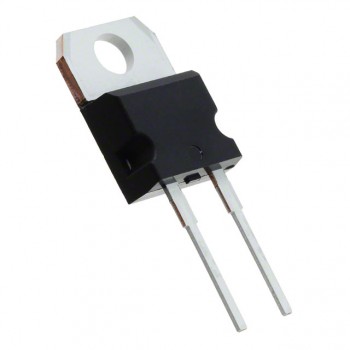A diode is a two-terminal semiconductor device that allows current to flow in only one direction. It is a crucial component in electronics and has various applications, such as rectification, voltage regulation, signal modulation, and switching. Diodes work based on the principles of semiconductor physics, where they exploit the behavior of electrical carriers (electrons or holes) under different voltage conditions.

How Diodes Work:
1. Diodes are made of two different types of semiconductor materials – p-type and n-type, doped with impurities to create an excess of either positive charges (holes) or negative charges (electrons).
2. The interface between the p-type and n-type materials is called the p-n junction. At this junction, electrons (negative) from the n-type region cross over and recombine with holes (positive) from the p-type region, forming what is known as the depletion region.
3. When a positive voltage (forward bias) is applied to the p-type material (anode) and a negative voltage to the n-type material (cathode), the depletion region narrows, allowing current to flow easily through the diode.
4. Conversely, when a negative voltage (reverse bias) is applied to the p-type material and a positive voltage to the n-type material, the depletion region widens, and very little current flows through the diode, effectively blocking the current.
Diode Selection Guide:
When selecting a diode for a specific application, consider the following factors:
1. Type: Different types of diodes serve different purposes, including rectifier diodes, Zener diodes, Schottky diodes, Varactor diodes, light-emitting diodes (LEDs), etc. Choose the diode type that best fits your specific application.
2. Maximum Forward Voltage (Vf): The forward voltage is the minimum voltage required for the diode to conduct (allow current to flow). Ensure the diode's Vf matches the requirements of your circuit.
3. Maximum Reverse Voltage (Vr): The reverse voltage is the maximum voltage the diode can withstand in the reverse bias condition without breakdown. Choose a diode with a Vr higher than the maximum reverse voltage expected in your circuit.
4. Forward Current Rating (If): This is the maximum current the diode can handle in the forward bias condition. The diode should have an If rating equal to or greater than the highest current expected in your circuit.
5. Reverse Recovery Time (trr): Reverse recovery time is especially important for high-frequency or switching applications. Fast switching diodes have a shorter trr, improving efficiency and reducing noise in such circuits.
Diode Popular Search Models:
STPS0540ZY STTH12R06G STTH1212D STPSC10H065D
STPS1H100U BAT54WFILMY STPS6M100DEE-TR STTH60RQ06W
FERD20H100SB-TR STPS8L30DEE-TR STPS2150AFN STBR6008WY

